When we think about trekking, we usually think about forts and search for trekking forts near me. But do you know there are many amazing trekking forts in maharastra, specially in pune.
Hey there! When we talk about pune, Junnar holds a distinctive historical importance, it’s hard not to think about Chatrapati Shivaji Maharaj and the iconic Shivneri fort, right? But guess what? There are actually 6 more forts hiding in Junnar, apart from Shivneri! For all you adventure seekers out there, these forts are like hidden gems waiting to be explored.
Junnar is such a vibrant tehsil in Pune district. It’s about 94.2 KM away from Pune city, and you can easily get there by bus or your own vehicle since there aren’t any trains available.
Now, here’s what makes Junnar even more special—it’s steeped in history! Plus, it’s the only tehsil in Maharashtra with 5 dams. And let’s not forget those breathtaking views of the Sahyadri mountain range you get in Junnar and forts in Junnar.
So, let’s talk about seven forts of Junnar! Along with Shivneri, there’s Chawand, Nimgiri, Narayangad, Hadsar, Jivdhan, and Shindola—7 forts waiting to be explored right here in Junnar. Stick around, because in this blog, we’re diving deep into each of these fascinating fortresses!
Amazing seven forts of Junnar:
Shivneri-
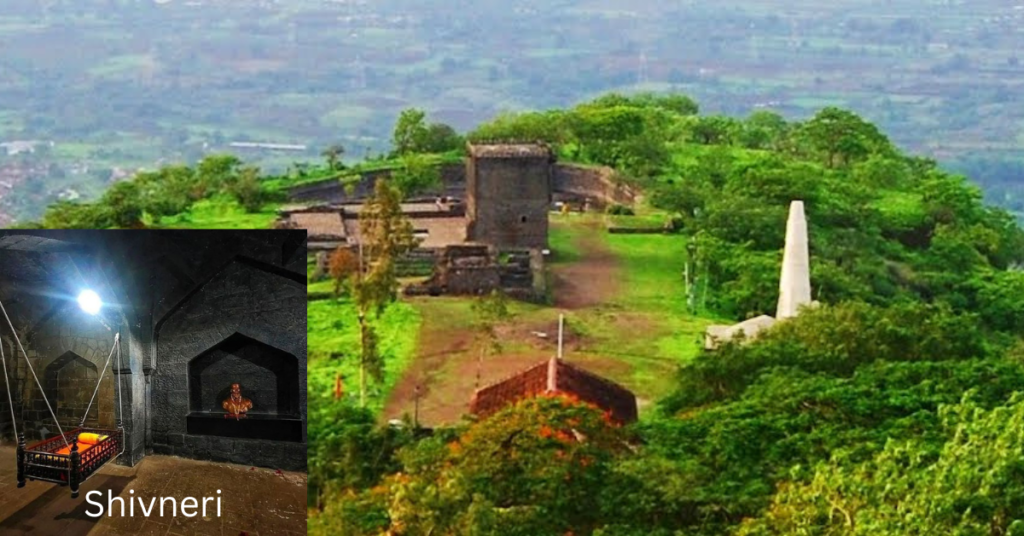
Shivneri Fort has a fascinating history dating back to the 6th century. Initially governed by various dynasties like the Mauryas, Chalukyas, Rashtrakutas, and Yadavas, it later came under the dominion of the Delhi Sultanate in the 13th century. By 1430, it was seized by the Adil Shahi dynasty of Bijapur. Interestingly, this fort holds a special place in history as it is the birthplace of the great Chatrapati Shivaji Maharaj.
Inside the fort, you’ll find a small temple dedicated to Shivai Devi, after whom Shivaji Maharaj was named. It’s where he spent his childhood. While the houses may not be visible today, the remnants of the royal palace, or rajwada, still stand. The fort is also dotted with several water tanks, including the prominent Badami Talav, along with smaller ones.
In the past, there was a convenient underpass route known as Bhuyari Marg, but unfortunately, it’s closed now. The fort boasts significant landmarks such as Ambarkhana, Shivkunj, the birthplace of Shivaji Maharaj, Kadelot Kada, and Sakhaldand.
Shivkunj is a poignant tribute to Shivaji Maharaj, with its establishment credited to the inaugural Chief Minister of Maharashtra, Shri Yashavantrao Chavan. Sakhaldand offers a challenging yet rewarding climb, featuring an iron chain and carved steps amidst the rugged rock face. This route, though moderately strenuous, typically takes around 45 minutes to navigate and can serve as a shortcut to descend from Shivneri Fort.
Notably, Shivneri Fort is fortified with seven gates, each serving distinct purposes: Mahadwar Door, Pir Door, Parvangi (Permission) Door, Hatti (Elephant) Door, Shipai (Soldier) Door, Phatak (Gate) Door, and Kulabkar Door. These gates collectively add to the historical richness and architectural marvel of this majestic fort. Shivneri is one of the great place to visit among seven forts of Junnar.
Chawand-

It’s a cool hill fortress not too far from Naryangoan in Maharashtra, India. Sitting pretty in the Sahyadri mountain range, it stands tall at 1,036 meters (3,399 feet) above sea level. It is just 17 KM from Junnar.
Now, if you’re up for the Chavand Fort Trek, here’s the scoop: you gotta take the route via Manchar-Narayangaon-Junnar, cruising along the Apatale road. Junnar is your go-to base village, hooking you up with the main road that leads to the fort. Oh, and while you’re en route to Chavand fort, why not swing by Shivneri fort too? Double the fun, right?
Now let’s dive into some history: Back in 1485, Malik Ahmed swooped in and kickstarted the Nizam Dynasty, snagging the Chavand fort post the Bahmanid Empire’s breakdown. Fast forward to 1818, and boom, the British took the reins.
But wait, there’s more! Shivaji Maharaj, that legendary figure, decided to spice things up and renamed the fort “Prasanna Gad”. Unfortunately, when the Brits took over, they kinda messed up the approach routes and trashed some structures. Bummer.
Now, let’s talk geography! From the tippy-top of Chavand fort, you’ll catch sight of the Manikdoh dam, chilling on the Kukadi river. Plus, you’ll spy two other rad forts, Jivdhan and Hadsar. Oh, and keep an eye out for the Seven Cisterns, although they got a bit banged up during the British attack. And guess what? There’s a temple of goddess Chamunda up there too, along with some cool caves to explore. How epic is that?
Nimgiri-

If you’re gearing up for the Nimgiri trek, your adventure kicks off at Khandechiwadi village. Getting there is a breeze if you first make your way to Junnar from either Pune or Mumbai. Once in Junnar, hop onto the road near the Manikdoh dam, which leads you to Ghatghar village, and from there, you’re on the route to Naneghat. It’s roughly 25 kilometers from Junnar and about 10 kilometers from Hadsar village.
Nimgiri and Hanumantgad are like a dynamic duo of forts, standing side by side in the Junnar area of Pune. Even though it’s called Nimgiri Fort, it’s actually closer to Khandi chi Wadi village, located about 25 kilometers ahead of Junnar.
As you embark on this trek, you’ll come across several bastions that are still holding strong, while other parts of the fort have succumbed to time and lie in ruins. Hidden within the thick foliage, you’ll stumble upon a weathered temple, originally slated for renovation but ended up receiving government funds for expanding the water reservoir nearby. The fort also boasts rock-cut cisterns and scattered remnants of buildings across its grounds.
During your trek, keep an eye out for the heroic stones known as VeerGal near the temple. Before reaching the fort, take a moment to explore a rundown temple, a water tank, the temple dedicated to goddess Kalubai, an idol of Lord Hanuman, and several war memorials along the way.
Once you reach the summit, you’ll find a winding path leading to a cave carved into the hillsides of Nimgiri. Initially used for surveillance, the cave now sits partially deserted, offering breathtaking views, especially during the monsoon season. Carved steps guide you to the gates of Nimgiri fort, known for its rugged beauty.
Be cautious as you ascend; some steps have weathered over time, and a few are missing altogether. But the challenge adds to the thrill, and reaching the fortress summit is nothing short of exhilarating. Along the way, you’ll encounter a sentinel post, a devdi, a nod to the fort’s history.
Alternatively, you can take a pathway that skirts the steps, offering panoramic views of the fort’s western flank. As you pass through a dilapidated gate surrounded by fortifications, you’ll spot three water cisterns along the trail. Inside a modest temple, you’ll find a sculpture of Gajalaxmi with a Shivling in the foreground, adding to the fort’s mystique.
Further exploration leads you to three caves, each with its own story. And atop the fort, you’re treated to panoramic views of neighboring treks like Chavand, Jeevdhan Harishchandragad, Hadsar, and Sindola. From its perch in the western valley of Junnar, Nimgiri fort overlooks Manikdoh and the Pimpalgaon dam reservoir, its architectural remnants whispering tales of days gone by.
Narayangad-
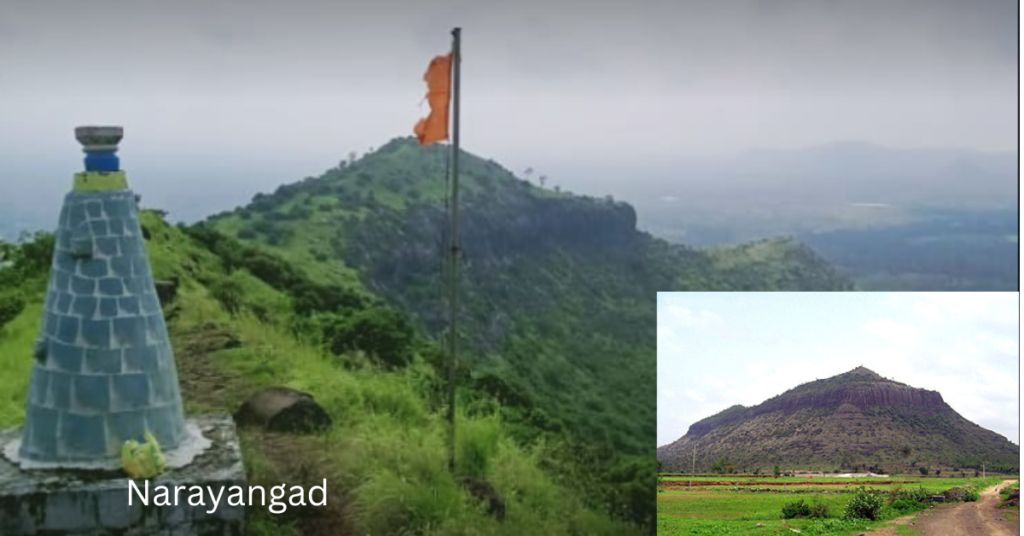
Narayangad, a charming hill fort about 80 km from Pune, is nestled close to Narayangaon, just 8 km away, and Khodad village, a mere 5 km distant. Nearby lies the quaint village of Gadachiwadi, adding to the fort’s allure. This historic landmark has left its mark on the surrounding area, particularly the Junnar taluka, home to another impressive fort, Shivaneri.
If you’re planning a visit, there’s a convenient bus service from Narayangaon to Khodad, passing through Narayangoan, with a stop at “GADACHWADI” about 7 km away. From there, you can start a trek amidst the serene natural surroundings.
History buffs will appreciate that the fort dates back to the Satvahana era, serving as a crucial lookout along the Junnar Paithan route. It underwent reconstruction during the tenure of the first Peshwa, Balaji Vishvanath (1714-1720), and was granted to Sayaji Povar as saranjam or a service grant. During the final Maratha conflict in 1818, Narayangad reportedly surrendered to the British.
Above the fort, you’ll find small waterponds named Narayan take and Chambar Take, especially enchanting during the rainy season when the greenery is at its peak. Trekking up the fort takes about 20 to 25 minutes. At the summit, you’ll discover the Temple of Goddess “Hastamata”, with the temple of “Mukaai” just below it. The hill also holds various ruins, including a stone doorway adorned with a figure of Ganpati and two tigers on its lintel. Every year, a jatra of Hastabai is celebrated on the day of the Nagpanchami festival.
The Giant Meterwave Radio Telescope (GMRT) project, located approximately 10 km away, has contributed to the fort’s recent popularity among trekkers. The fort is oriented in the North-South direction, with its main entrance conveniently situated on the western side, near the Mukaai Mata temple.
Hadsar-
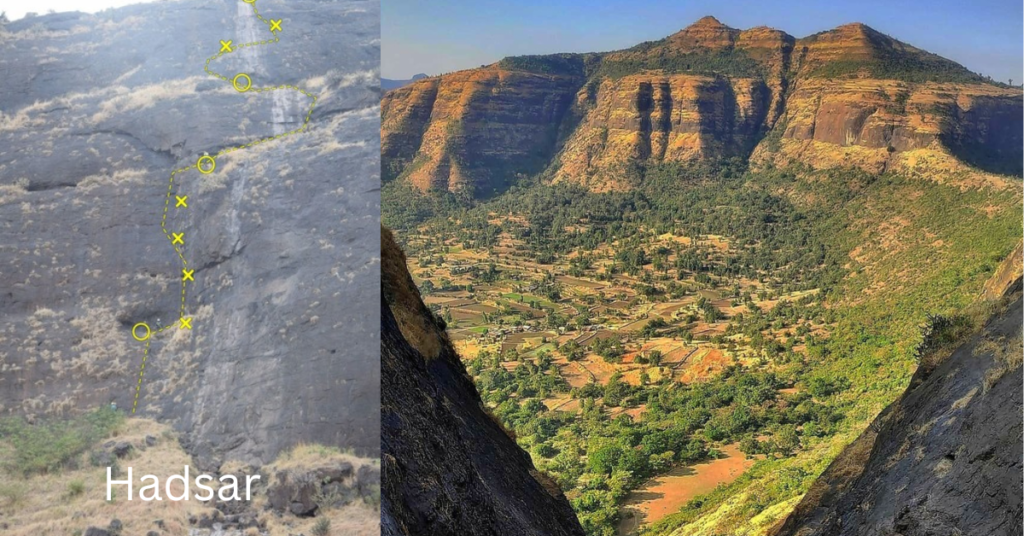
Legend has it that the construction of this fort dates back to the Satavahana Era. Documented evidence of its existence surfaces in the Treaty of Purandar, signed between King Shivaji and the Mughals. Subsequently, the fort fell into British hands in 1818.
Hadsar Fort is situated near Hadsar Village, which is approximately 13 km to the North-West of Junnar. To reach the summit of the fort from the village, there are two paths available. The easier route is from the southern side, passing through the main gate.
Alternatively, one can opt for the northern approach, which involves climbing a rock path approximately 20 feet in height. This climb offers a thrilling yet challenging experience, with rock-cut holds and thrusts to rely on. It is strongly recommended to seek assistance from climbing experts equipped with appropriate apparatus and ropes. For those embarking on this adventure, a night stay can be arranged in Mahadev Village.
For avid trekkers who seek adventure, this fort stands out as the perfect choice among the many trekking forts near Pune.
Hadsar Fort is one of the numerous forts in the Junnar region of Pune district, originally constructed to safeguard the ancient commercial trade route from the Mawal region to Kalyan through Naneghat. It boasts a remarkable architectural feature with intricately designed bastions and a fort entrance, unparalleled in its craftsmanship elsewhere.
What sets this fort apart is its remarkable entrance gate construction. Carved entirely from a single rock, the entrance gate, sentry rooms, water cisterns, and steps leading up to the fort showcase intricate craftsmanship. At the summit of the fort, a temple dedicated to Mahadev stands proudly. Within the temple, stone-cut idols of Ganesh, Garud, and Hanuman adorn the sacred space. Additionally, a sizable lake graces the landscape of the fort, adding to its allure.
Jivdhan-
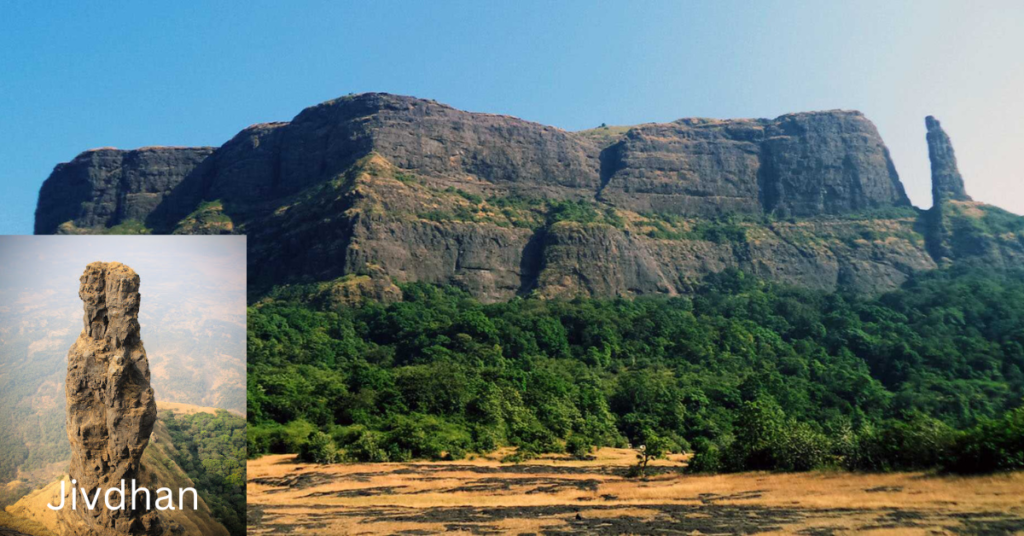
Jivdhan, also known as Jeevdhan, is a hill fortress positioned just 1 km away from the contemporary town of Ghatghar in Junnar Taluka, within the Pune district of Maharashtra, India. Towering at an elevation of 1,145 meters (3,757 feet) above sea level, this fortress is nestled within the scenic Sahyadri mountain range.
This forts origins also date back to the Satavahana era. Each entry point on the forts built by Shivaji Maharaj features a ‘Kalas’ and a carving of Lord Ganesh. Nearby, Naneghat, functioning as a toll collection booth, facilitated commercial activities for traders, easing the movement of goods across this crucial pass linking the seas to the mainland. Due to its strategic significance, the pass was vigilantly guarded against enemy incursions, with Jivdhan fort serving as a key bastion in safeguarding the interests of various kingdoms.
Notably, during the reign of the Adilshahi dynasty of Ahmednagar, the young Murtaza, last emperor of the dynasty, was held prisoner by the Mughals at Jivdhan fort. In 1635, Shahaji, father of Shivaji, secured Murtaza’s release from captivity, subsequently declaring him the King of Ahmednagar. The stretch from Jivdhan to Naneghat spans an open field of 2–3 km, providing clear visibility for detecting enemy advances.
In 1818, Colonel Prother of the East India Company led the capture of the fort, later ordering the destruction of certain sections of the stronghold.
The Jivdhan Fort Trek is among the renowned five treks forts in Junnar region. If you’re traveling by private car, you can combine them into a two-day itinerary, including Hadsar Fort, Naneghat Ghat, Shivneri Fort, Chavand Fort, and Jivdhan Fort, the famed quintet. Alternatively, the Jordan Naneghat trek offers the opportunity to visit two locations in a single trekking excursion.
For first-time trekkers, the Jivdhan Fort Trek route presents challenges, particularly on rock climbing sections where climbing equipment is necessary. Navigating through the jungle trail can be tricky and may lead to confusion. Notably, the ascent to the Kalyan Gate is facilitated by brilliantly carved rock-cut steps on Jivdhan Killa, with hooks strategically placed to aid trekkers. The Jivdhan rock patch stands out as a highlight along the trek, offering a memorable climbing experience.
Up on the fort, there are a couple of water tanks. It’s good to know that the water from the tanks close to the storehouse isn’t safe to drink as they stay open throughout the year.
However, you can rely on the water from the rock-cut cistern near the Kalyan Gate, it’s safe to drink. Oh, and watch out for the prickly shrubs covering the entire fort, known as Lepidagathis cuspidata or Kate adulsa in Marathi. And keep your eyes peeled for the Malabar giant squirrel, also known as “Shekhru,” in the forest at the foothills.
Now, let’s talk about this impressive pinnacle nearby. It stands tall at about 385 feet! From a distance, it might not seem that big, but as you get closer, you’ll realize its sheer height. They call it ‘Vanarlingi’. Climbing it is possible with the right rock climbing gear, but be prepared—it might take a day or two. Oh, and make sure to check for beehives around to ensure a safe climb.
Once you’re up at the fort, you’re in for a treat! The views are breathtaking. You’ll get a clear sight of various hilltops and forts nearby, like Harishchandragad, Chavaand, Ratangad, Naneghat, Hadsar fort, Nimgiri fort, Manikdoh Dam, and the entire Junnar plateau. It’s quite a sight to behold!
Sindola Fort-
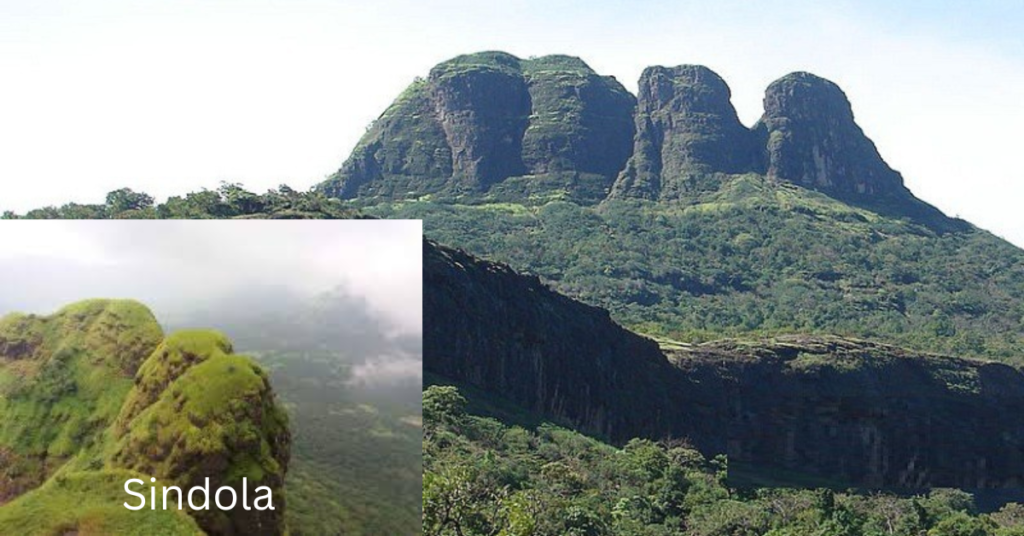
Hey there! Have you heard about Sindola fort? It’s this charming little hill fort nestled in the Junnar region of Maharashtra, right up there on the Malshej Ghat Plateau. You might think what makes Sindola stand out is its unique pinnacle structure? that you can spot from just about anywhere around. It’s like a tiny military base, giving you this awesome panoramic view of Malshej and Pargaon regions, along with all the neighboring forts. And get this, Sindola’s history goes way back, almost as old as Nimgiri and Hadsar forts!
For those embarking on the Sindola fort trek, the trail can be divided into three sections: a leisurely field walk from the highway to the plateau, followed by a gradual ascent to the first ridge, and finally, a rocky and narrow traverse leading to the fort itself. Each segment offers its own adventure and stunning vistas, promising an unforgettable journey amidst nature’s splendor.
Experience an exhilarating ridge walk surrounded by stunning mountains and the glistening Pimpalgaon Joga dam on the Sindola Fort trek. As you traverse the ridge, the sight of the Sindola fort itself is a treat for the eyes.
To your right, admire the pristine waters of the Pimpalgaon Joga dam, while on your left, catch glimpses of majestic peaks like Devdandya, Bhojgiri, and Nimgiri-Hanumantgad. The ridge offers panoramic views of numerous forts in the Malshej Ghat region, yet the ridge walk itself is a spectacle to behold.
Look out for the spectacular Karvi/Karwi flowers, which bloom once every seven years, adding a rare and enchanting touch to the trail. Along the trek, you’ll also encounter an array of other beautiful wildflowers adorning the surroundings.
The pinnacle structure of Sindola fort sets it apart, visible prominently across the Malshej Ghat region and particularly striking from the second ridge viewpoint.
The Sindola Fort trek offers something unique in every season, so you’re in for a treat no matter when you go!
If you’re into lush greenery, colorful flowers, and misty mountain views, plan your visit for May-June or September-October. These months paint the landscape with vibrant hues and dreamy clouds.
For crystal-clear vistas of Sindola Fort, majestic mountains, and neighboring forts, mark your calendar for November through February. During this time, you’ll catch the scenery in all its clarity.
However, trekking during the monsoon season can be quite risky. The trails get slippery, and strong winds might throw you off balance. It’s best to avoid trekking in these months for safety reasons.
Since there aren’t many trees along the trekking route, summers can get scorching hot and make the journey quite challenging. Therefore, trekking in the summer months isn’t recommended due to the intense heat.

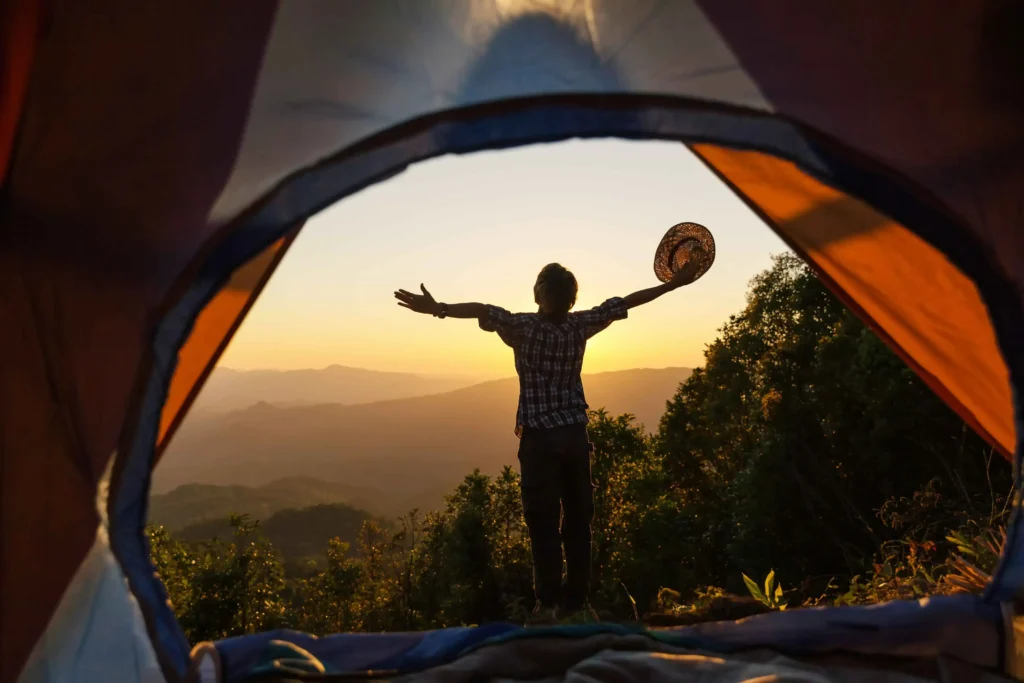

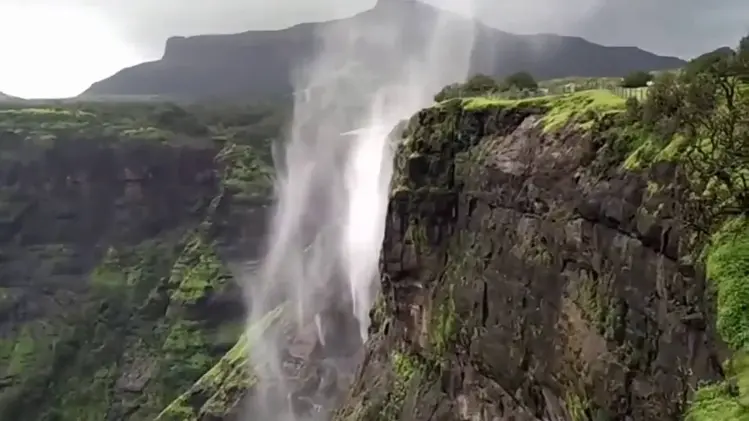
Very nice information. keep it up.
I was recommended this website by my cousin I am not sure whether this post is written by him as nobody else know such detailed about my difficulty You are wonderful Thanks
Thanks for reading and I appreciate your interest, but this article it written by us, we know every details about this forts because we are local and visited forts many times.
very good content.